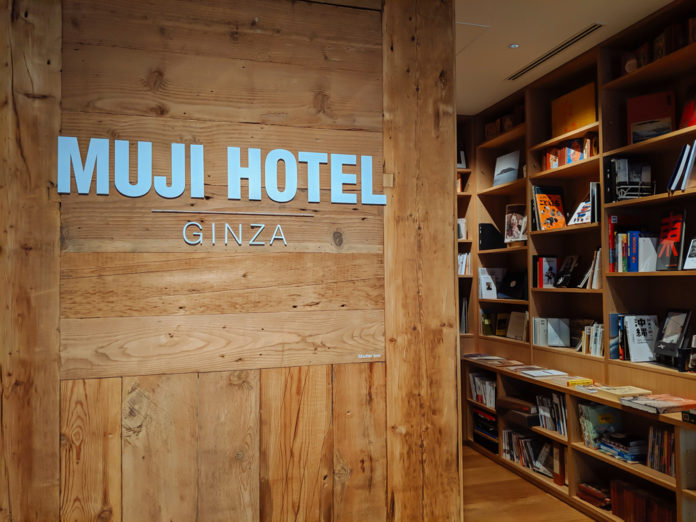What it’s like to stay at Muji’s Ginza Hotel
When I heard that Muji Hotel Ginza would be opening just in time for our planned trip to Japan, I couldn’t resist booking a couple nights to finish out our vacation! After 3 weeks of mainly Airbnb stays, it was a welcome change.
Muji’s Ginza location is actually their first in Japan, as well as their first outside of China. Their first two hotels are located in Shenzhen and Beijing. Muji’s sleek, modern hotels reflect their signature minimalist design aesthetic and provide an immersive brand experience, as well as literally serving as a showroom for many of their home goods.
Booking Muji Hotel Ginza
I usually check third party sites before booking, as hotel prices can vary quite a bit. In the beginning, booking was only available through Muji, however, they’ve since opened up availability on Booking.com.
When booking on Muji’s site, be sure to select the English language option from the top right of the website before you click on “Reservations”, as language choice doesn’t seem to be available once you’re on the booking page.
Once you’re on the English language booking page, it’s pretty self explanatory. You can see all of the available room types for your travel dates, and choose to pay in advance or pay at check-in. Don’t be surprised if you don’t see the full range of rooms available. As of publication, they seem to be pretty booked up even 6 months out.
The photos available on the booking page aren’t actually as helpful as the Rooms section Muji has added to the website. The room illustrations are particularly helpful in getting a better sense of the room size and layout–I’m not sure why they haven’t added this info to the booking page.
Location
Set in Tokyo’s posh Ginza neighborhood, the Muji Hotel is located on floors 6 through 10 of their huge Ginza store, with the floors below dedicated to shopping and dining, including the Muji Diner, bakery, juice bar and ice cream counter.
I enjoyed the exposure to a Tokyo neighborhood that I hadn’t spent much time in on prior trips, but wouldn’t go out of my way to stay in the area again. The area is filled with designer shopping, much of it the same items you could buy in any major city. There are of course some fantastic restaurants in Ginza, and window shopping is free for the budget minded. Ginza is also close to Tsukiji market, and not far from the new Toyosu fish market, so the Muji Hotel can serve as a convenient base for early morning visits to the market.
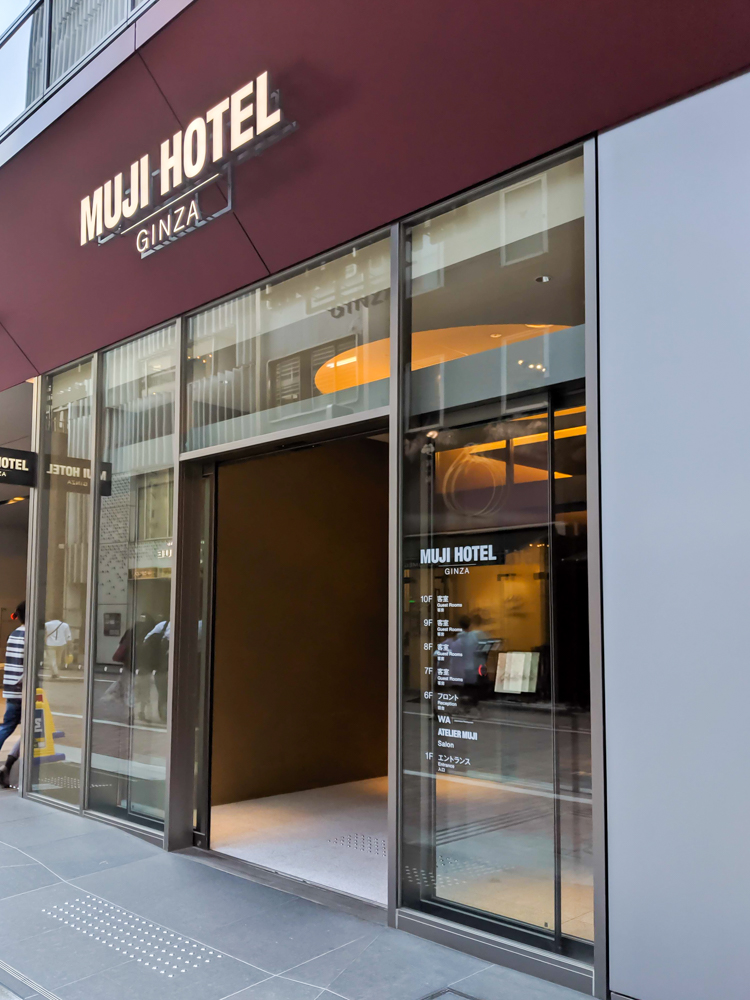
During regular hours, hotel guests can enter via the main store entrance or the dedicated hotel entrance in the back of the building (pictured above). Outside of store hours, only the back entrance is available, and a key card is necessary to operate the elevators. We weren’t aware of the back entrance at first, and dodged approximately 400 shoppers and tourists getting to the elevators and up to check-in.
Check-in
If you take the elevators from the back entrance, you’ll step out directly to the check-in desk.
In each of their hotels, Muji has made an effort to include recycled materials of local significance. Here, it’s 100 year old trolley paving stones creating a striking lobby centerpiece at the check-in desk.
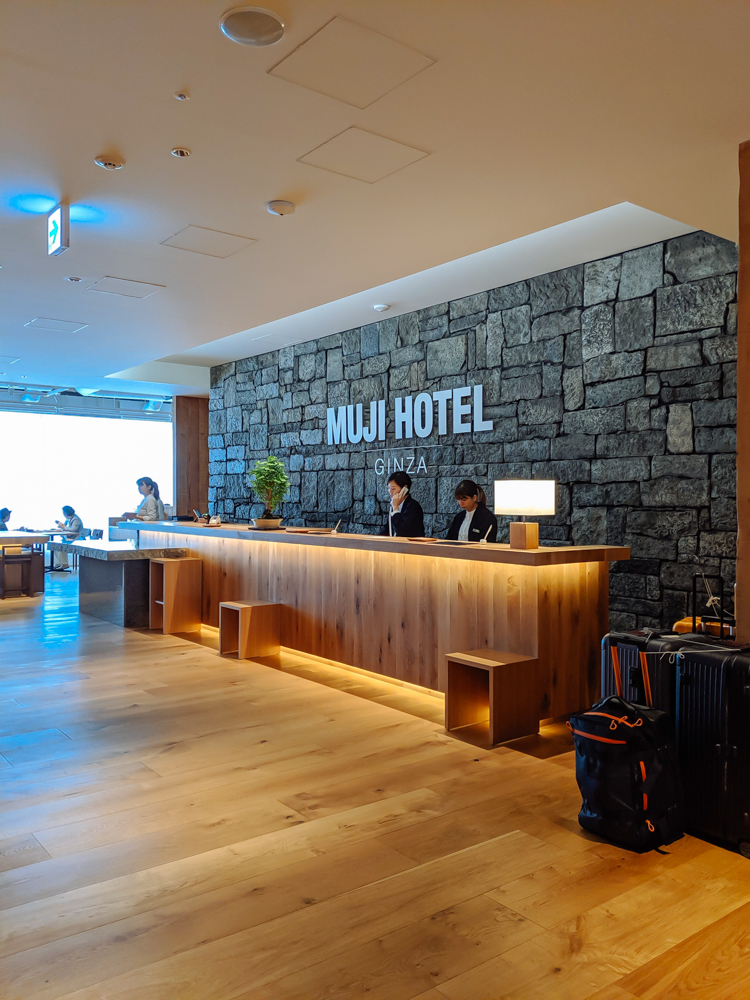
Front desk staff were polite, careful and thorough (which did translate into a rather slow check-in experience). Most spoke English, though with varying degrees of fluency.
We arrived about 20 minutes before official check-in began at 3pm. Staff completed most of the check-in process, and were asked to sit and wait until exactly 3 to receive our key card. This felt a little silly, as I doubt there was a maid frantically cleaning the room at the last minute. But it also felt very Japanese, one of those cultural quirks it’s not worth pushing back on.
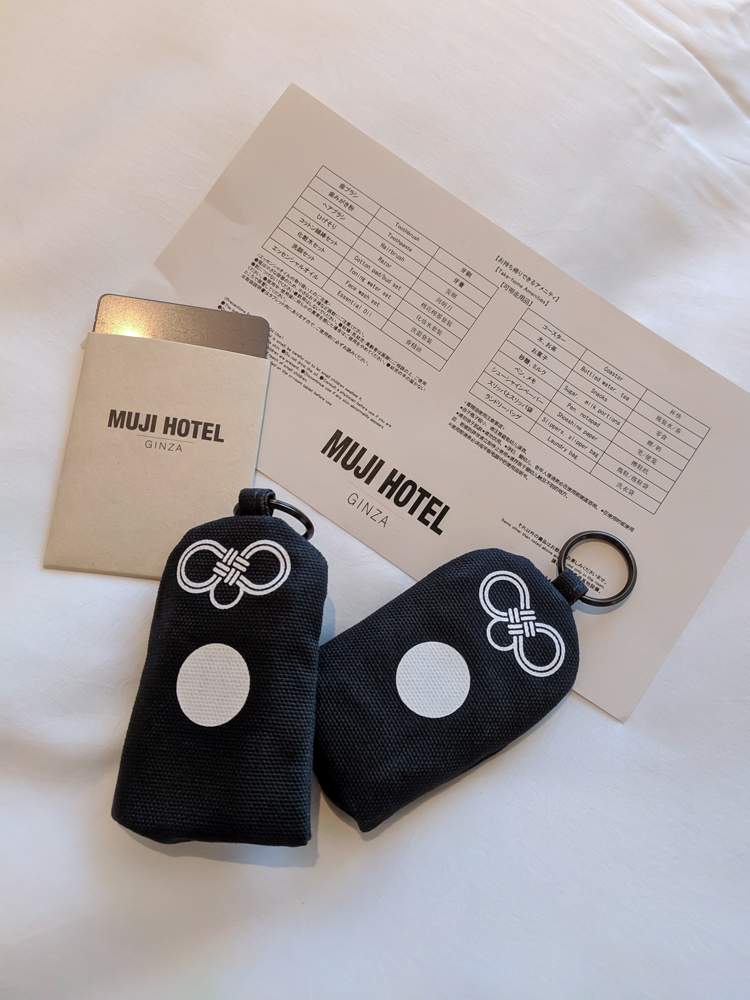
In addition to the key cards, we were given a sheet that delineated which in-room amenities could be taken home (not many), a choice of lavender or grapefruit oil to use in the in-room diffuser, and an omamori style charm bag with emergency info and whistle in case of an earthquake. Not quite a fancy room key, but still a nice touch.
Rooms at Muji Hotel Ginza

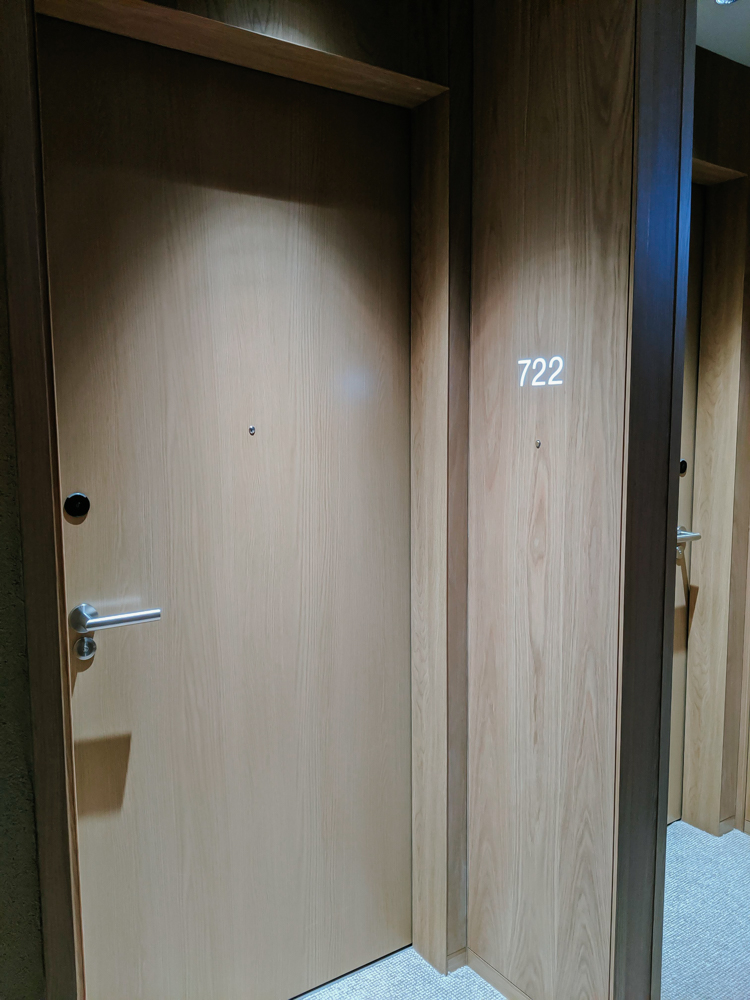
Rooms for the first couple months booked up quickly, so I ended up staying one night in a Type E room, then switching to a Type G room for the following two nights. While it wasn’t what I’d originally hoped for, it turned out to be a great way to compare rooms.
The Type E Room

Both rooms have a long, narrow footprint with bathrooms along a hallway at the room entrance, and beds at the far end of the room next to the windows. My wide angle lens stretched the perspective a tad in some photos, but it really is a long, narrow set up. Still, the rooms felt fairly spacious for a Japanese hotel room; cozy but not cramped.
With their incorporation of “wood, stone and earth” — and particularly warm woods throughout — the minimalist lines of the hotel never feel sterile or cold.
The Type E room was the larger of the two at almost 400 square feet. It features two twin beds (a third bed can be added for an additional charge to accommodate three people) on an elevated tatami platform, along with a small sofa and desk.
The room was comfortable for two people, though as with all smaller hotel rooms we had trouble finding spots to open up both our suitcases. I rarely completely unpack and stow my bag, and I wish more hotels would provide better luggage space (or even luggage racks at all!).

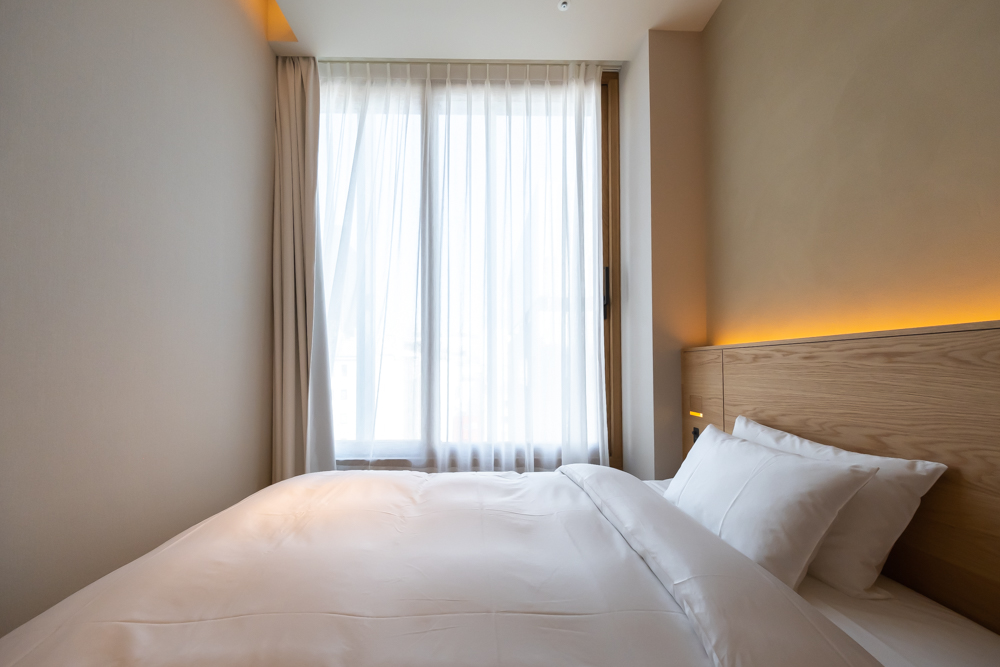
The Muji mattresses, in keeping with Japanese preference, are very firm. Noticeably firmer even than my “very firm” mattress at home. This was a bit of an adjustment, but fine for me, not complaining. However, if you prefer a soft mattress, this could be dealbreaker. (It can be difficult to find a soft mattress in Japan, but in general, higher end luxury brands like the Ritz Carlton will have softer mattresses, and I’ve heard good things about Prince Hotels as well).
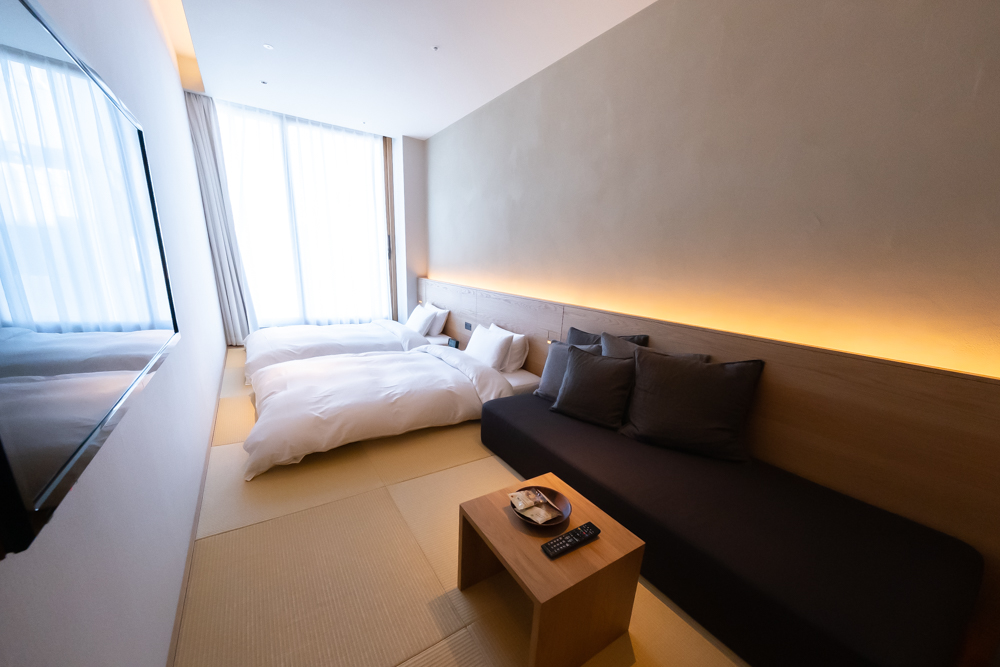
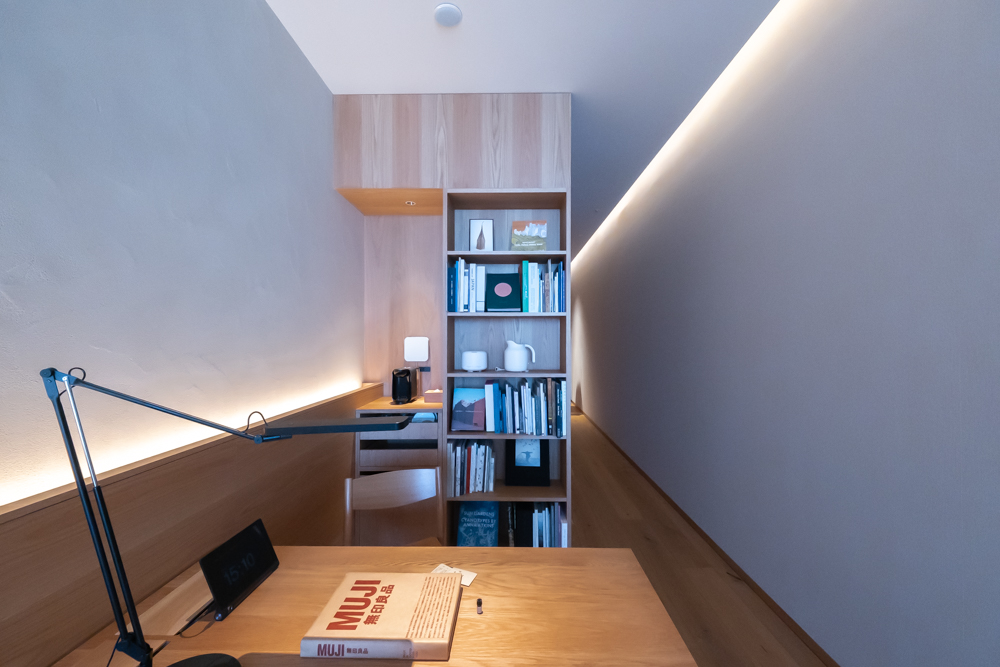
The bookshelf is stocked with a variety of gorgeous photo books and Japanese language books, a feature that I really enjoyed!
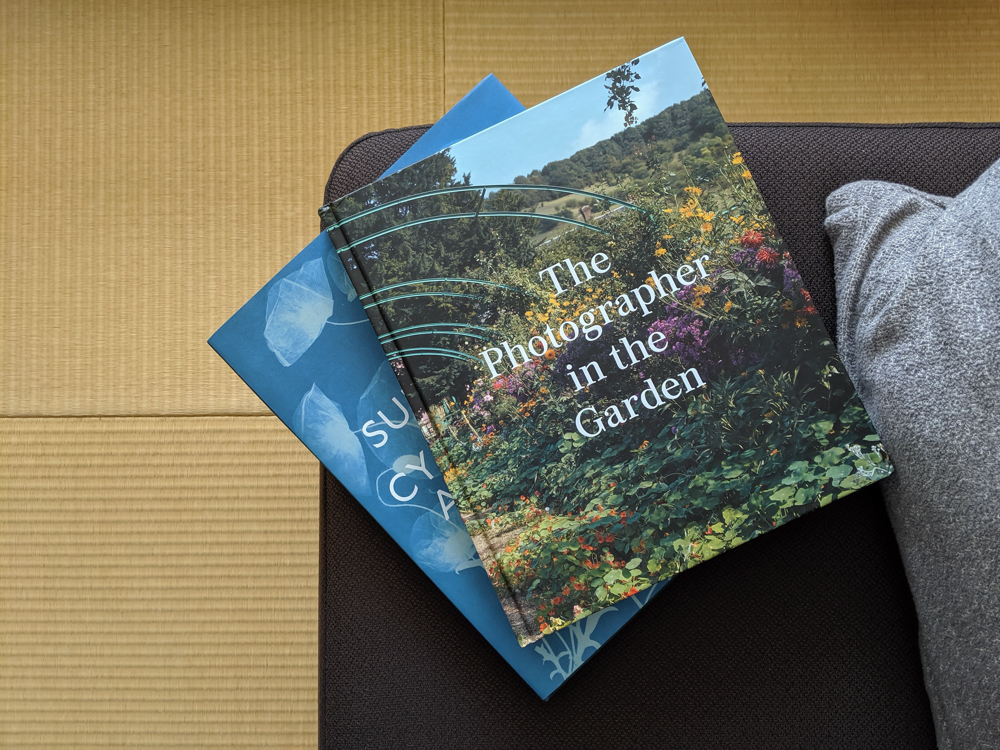
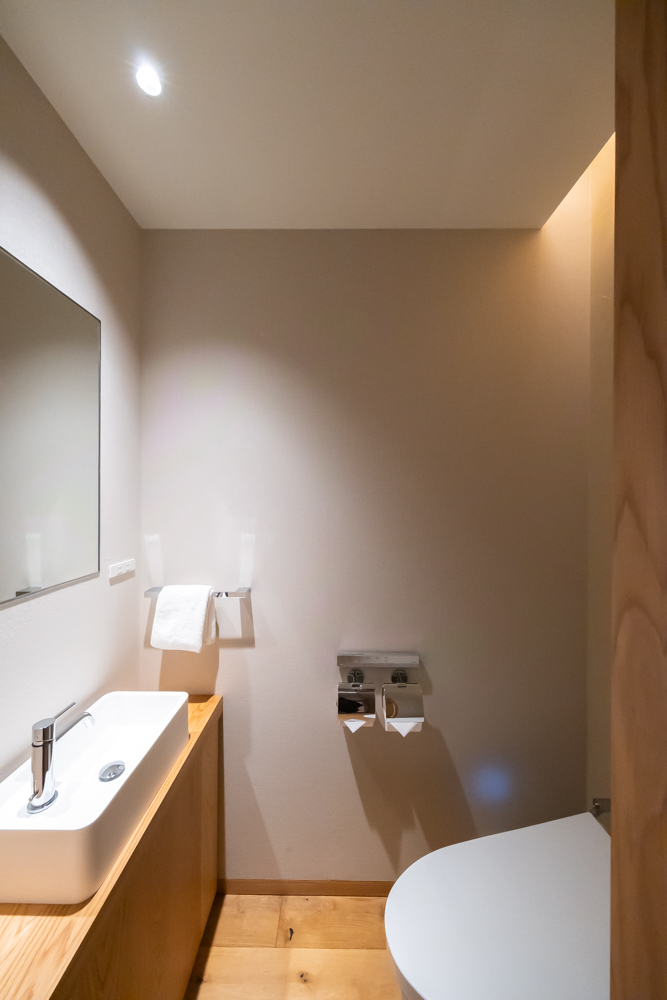
The Type E room had the nicer bathroom, with a separate toilet room. This setup is traditional in Japan, but smaller hotel rooms and Western hotels often choose to save space and combine them. I’m always happy to find them in separate rooms! The toilet is a full feature washlet toilet.
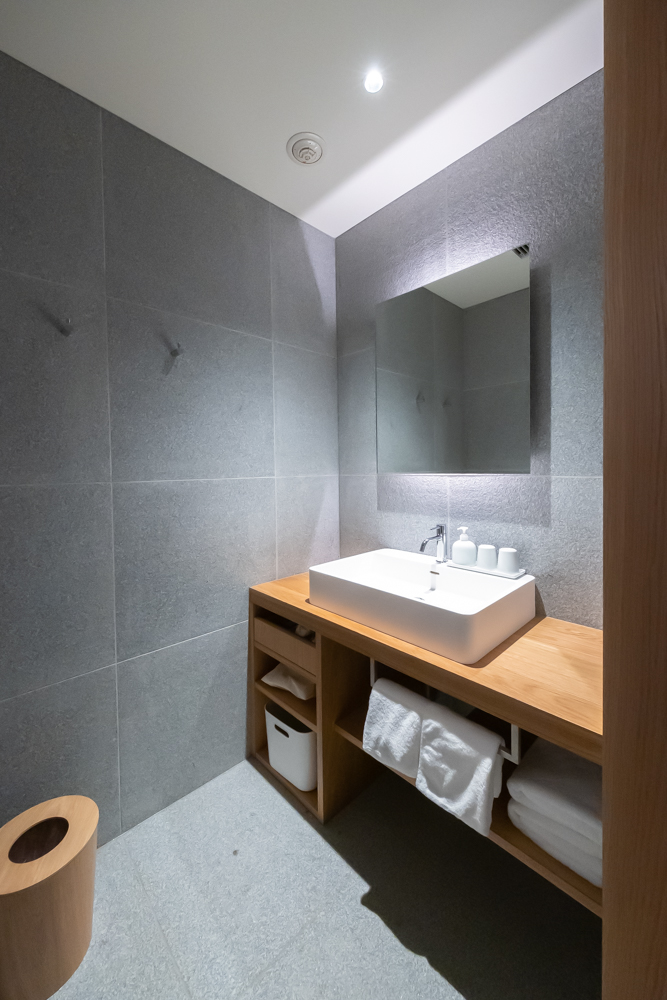
The bathroom has a spacious shower with a soaking tub. Also a plus in my book, the counter featured plenty of space to spread out my copiously overpacked toiletries.
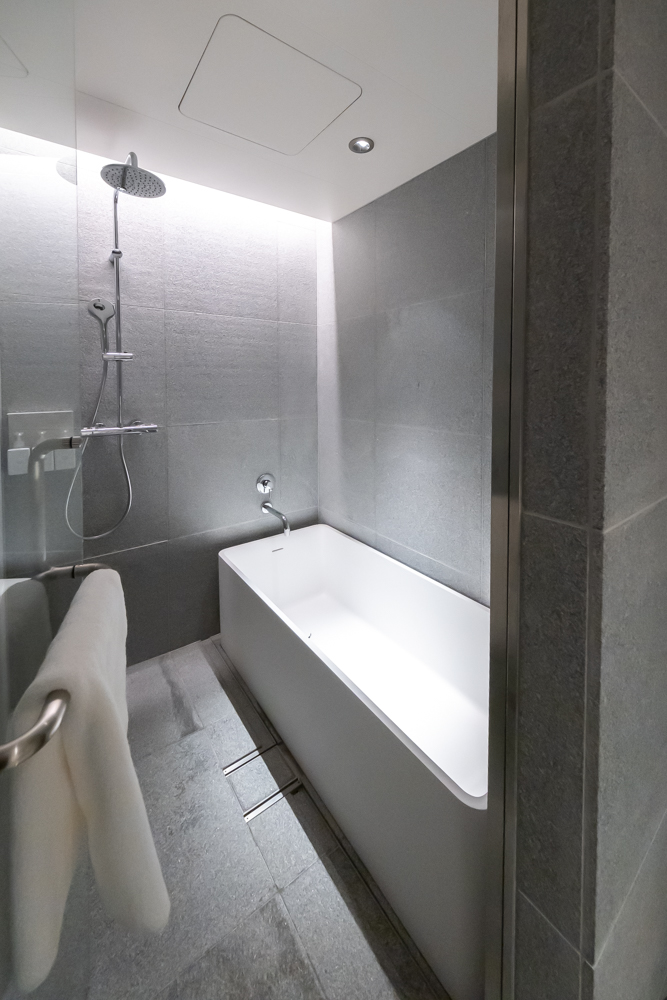
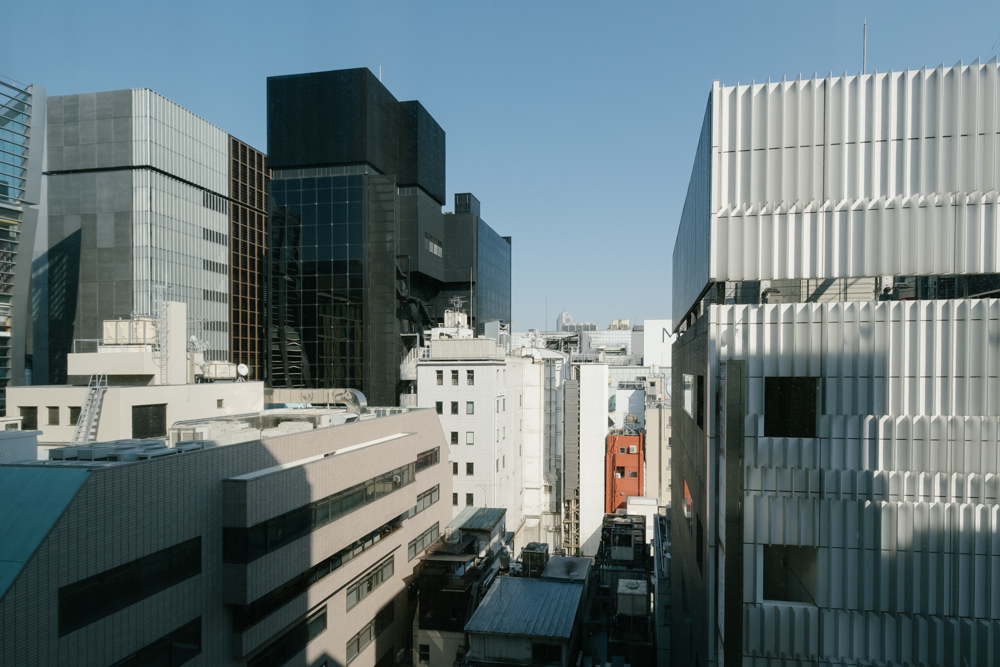
The view from the room (on the 7th floor) wasn’t anything amazing, though views may be better on higher floors.
The Type G Room
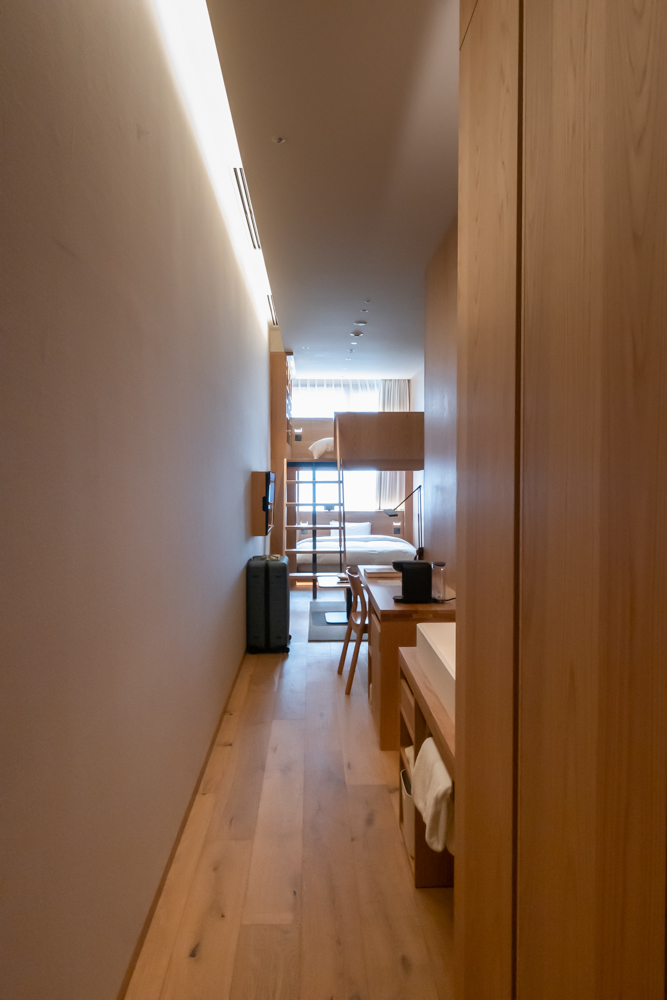
Muji’s Type G bunk bed room has a similar room footprint, but measures slightly smaller at about 269 square feet. You enter to a long hallway with the closet and bathroom to the right, and the room opens up to full width at the back.
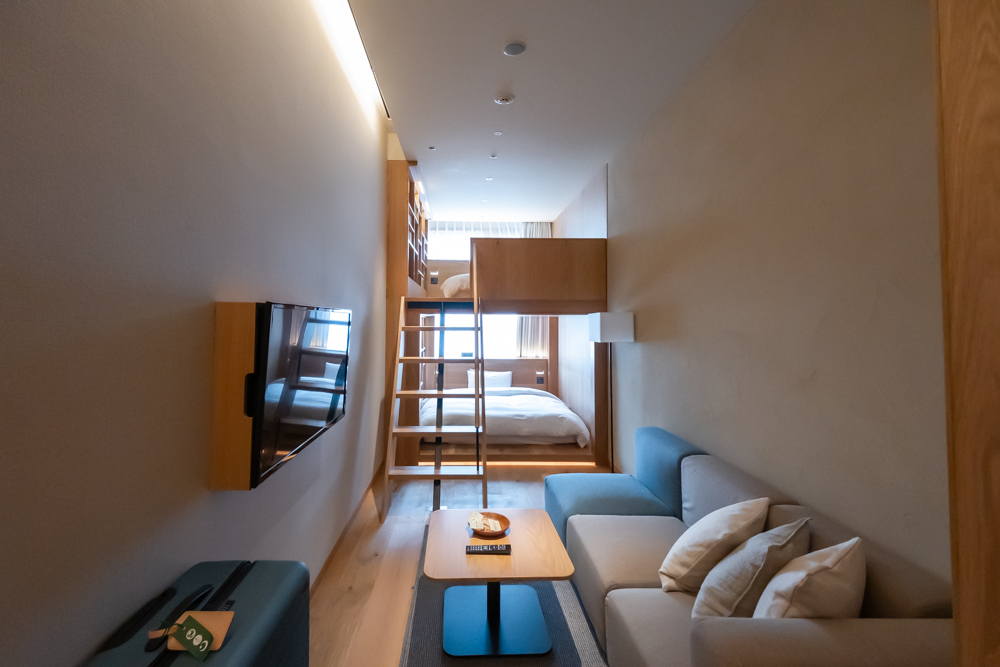
This room was a tad smaller overall, but includes a larger sofa and sitting area.
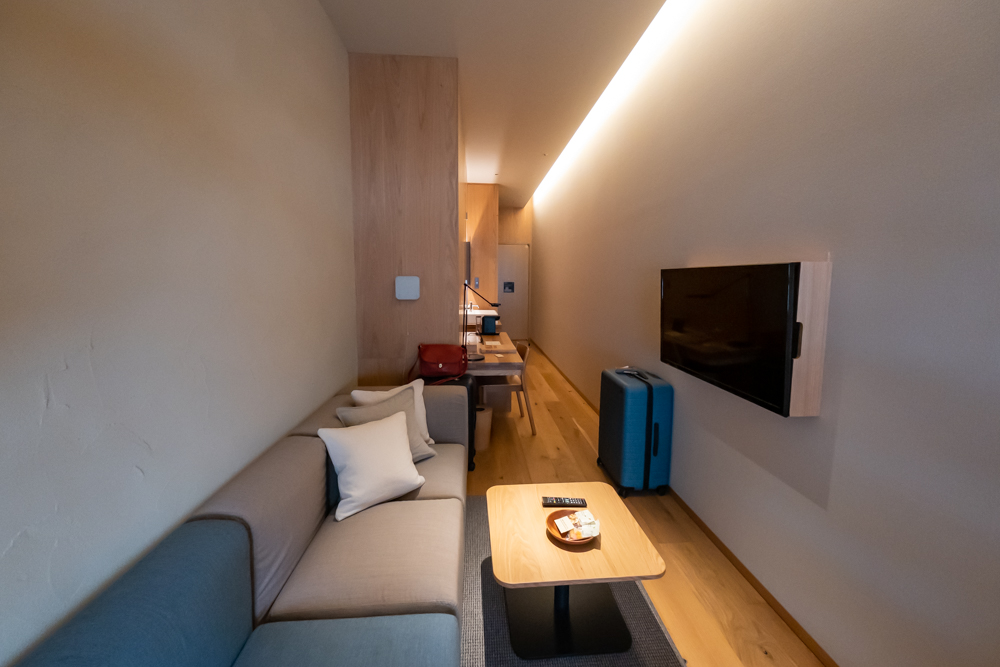

While the Type G room does not have a separate toilet, there’s a second sink in the hallway outside of the bathroom. Honestly, this wasn’t especially useful, and I’d have much preferred a luggage rack here.
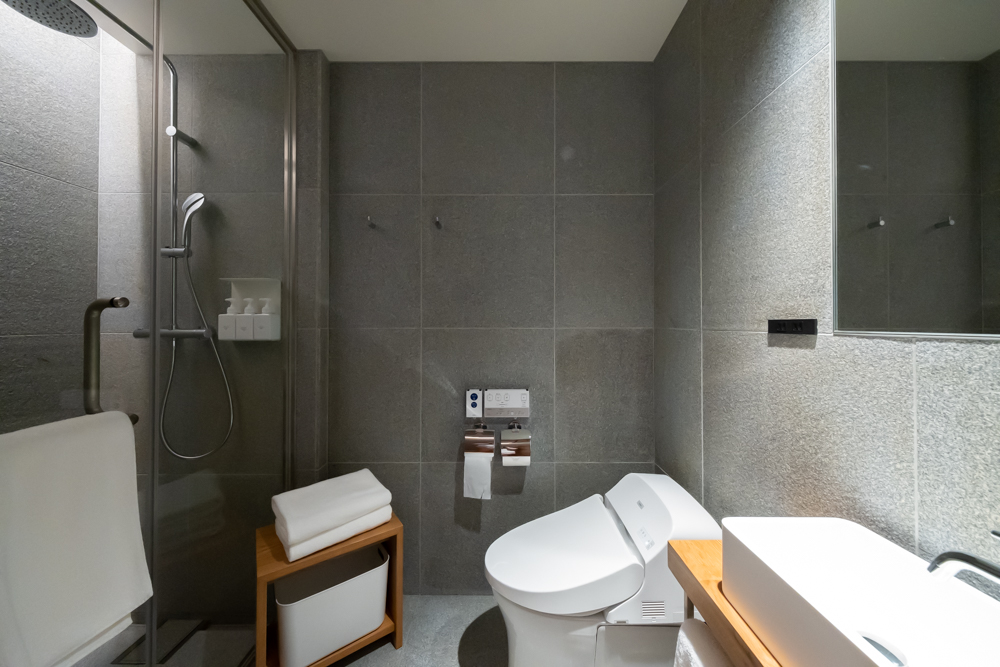
The bathroom in the Type G room is all in one, and includes just a shower, with no bathtub. Still, the bathroom and the shower itself were a good size and didn’t feel cramped.
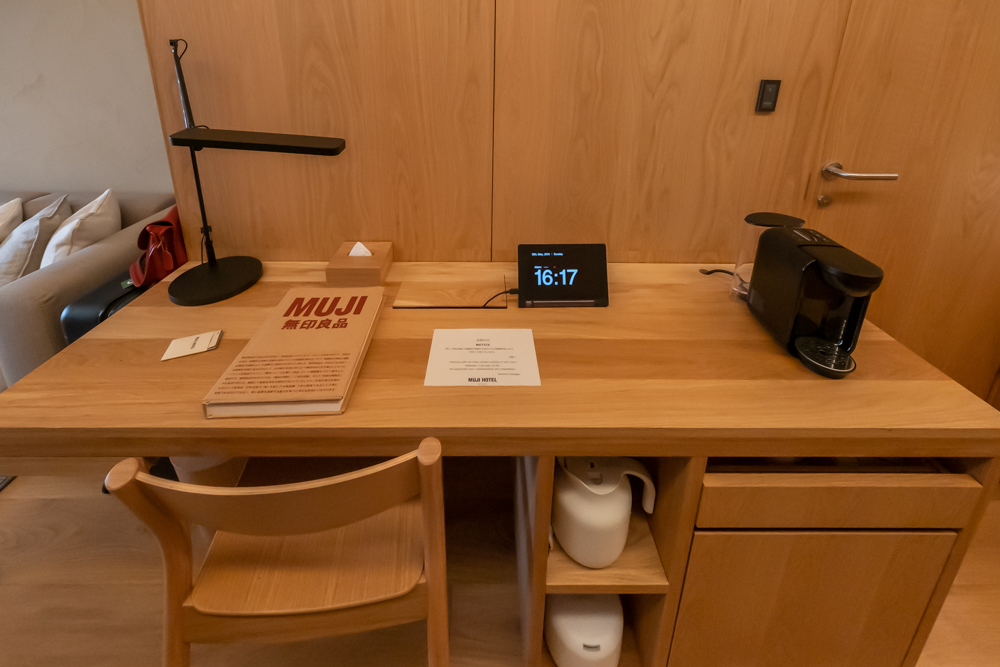
Also along the hallway is the desk. A slightly more cramped setup compared to the Type E room but perfectly functional.
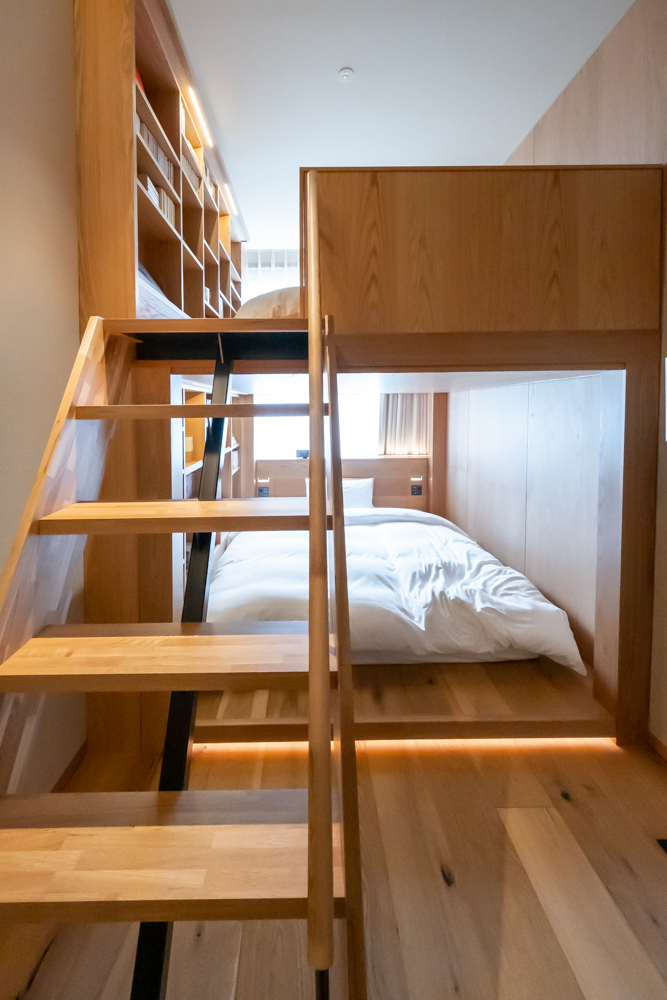
The bunk bed concept could have been gimmicky, but is surprisingly well executed. Bunks feel cozy but spacious, and the beds were definitely adult sized. The top bunk is a double size, and the bottom is approximately a queen size. The stairs feature wide slats that aren’t too steep.
With both rooms, I was really pleased that they were both beautiful and comfortable–I do have a weakness for the occasional gimmicky hotel, and it’s always a pleasant surprise when they’re legitimately wonderful stays.
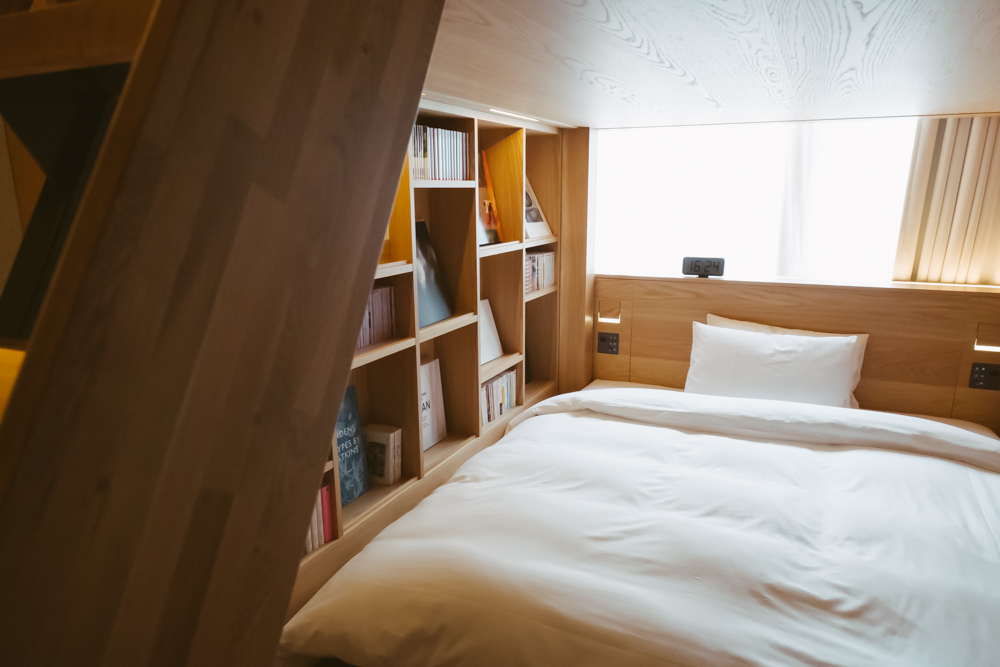
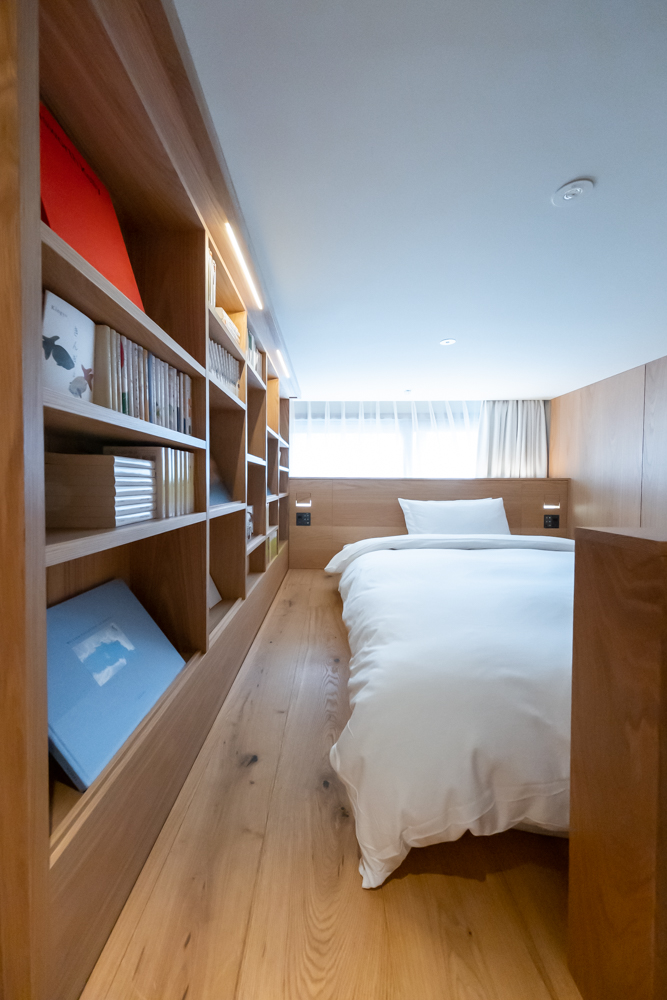
As with other rooms, beautiful books are significant feature. It was especially nice to be able to pull a book from the shelves while lounging in bed.
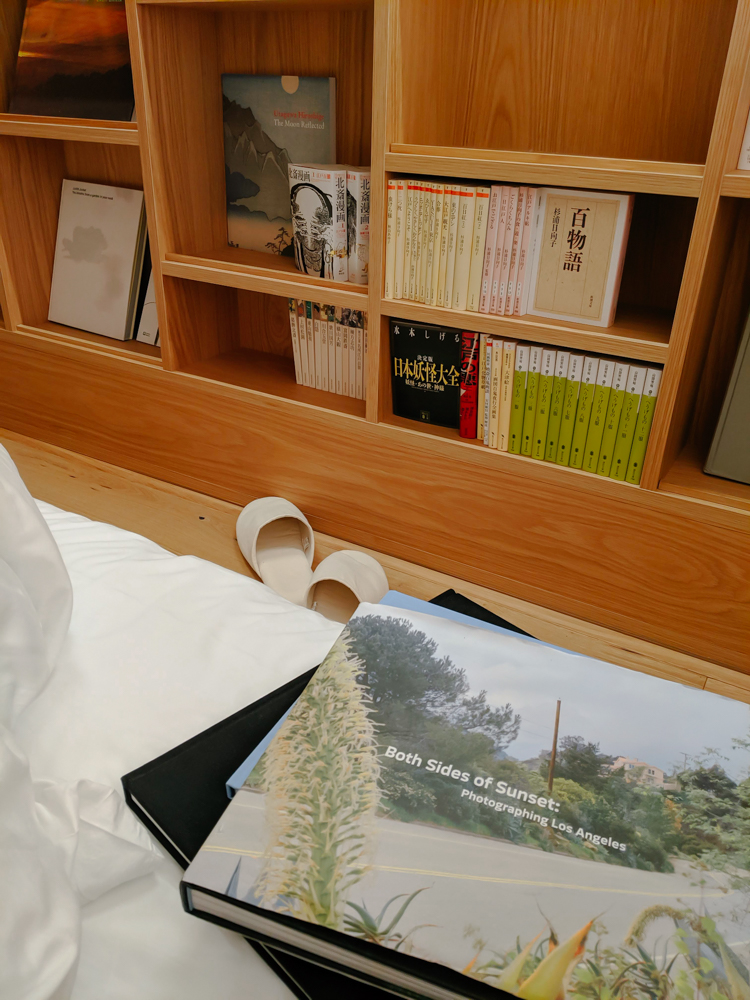
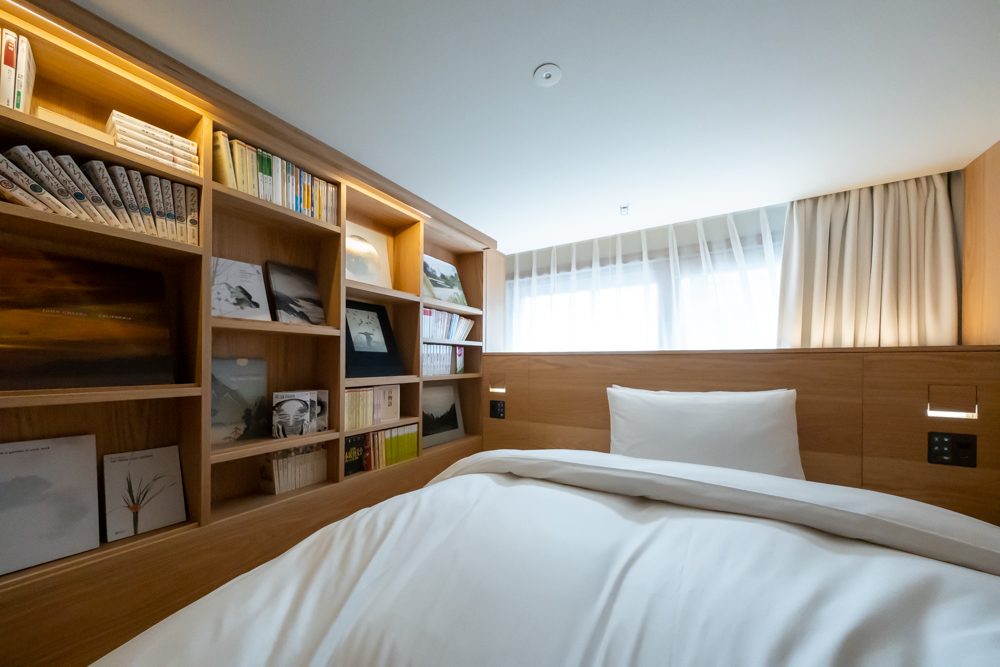
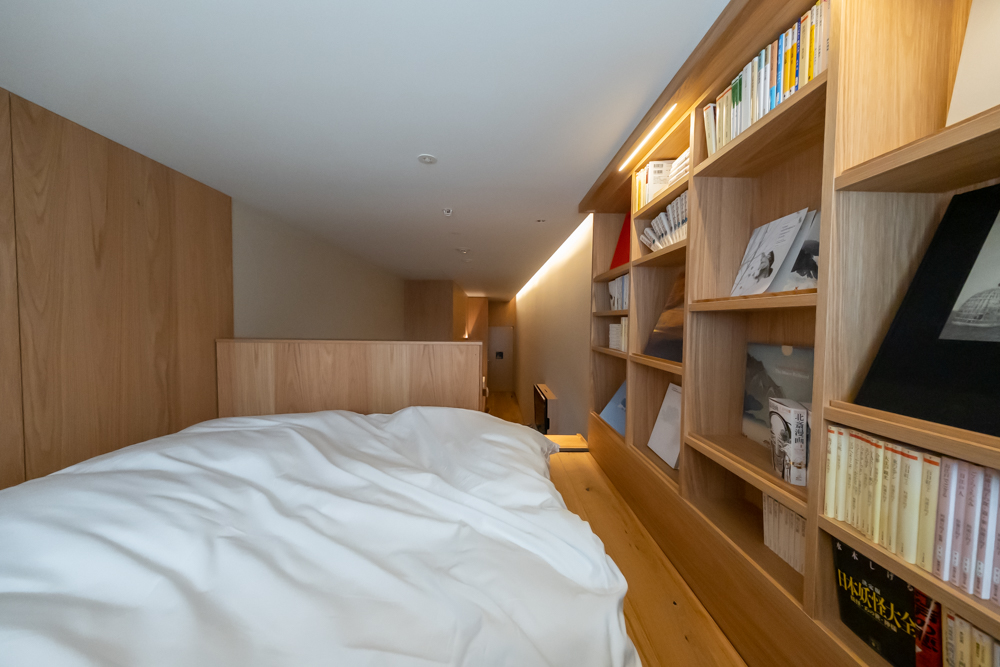
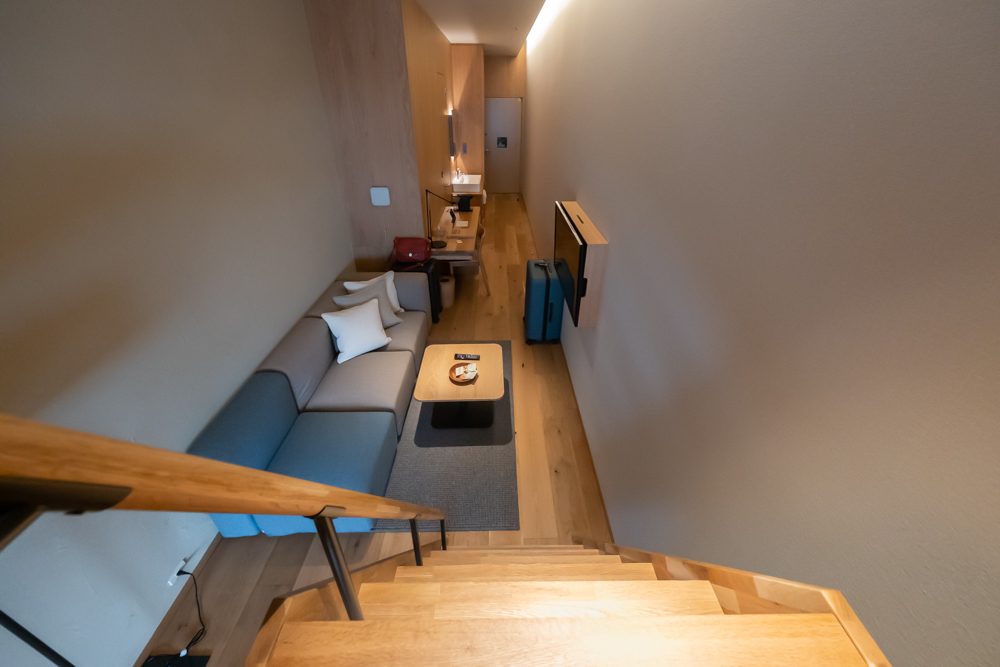
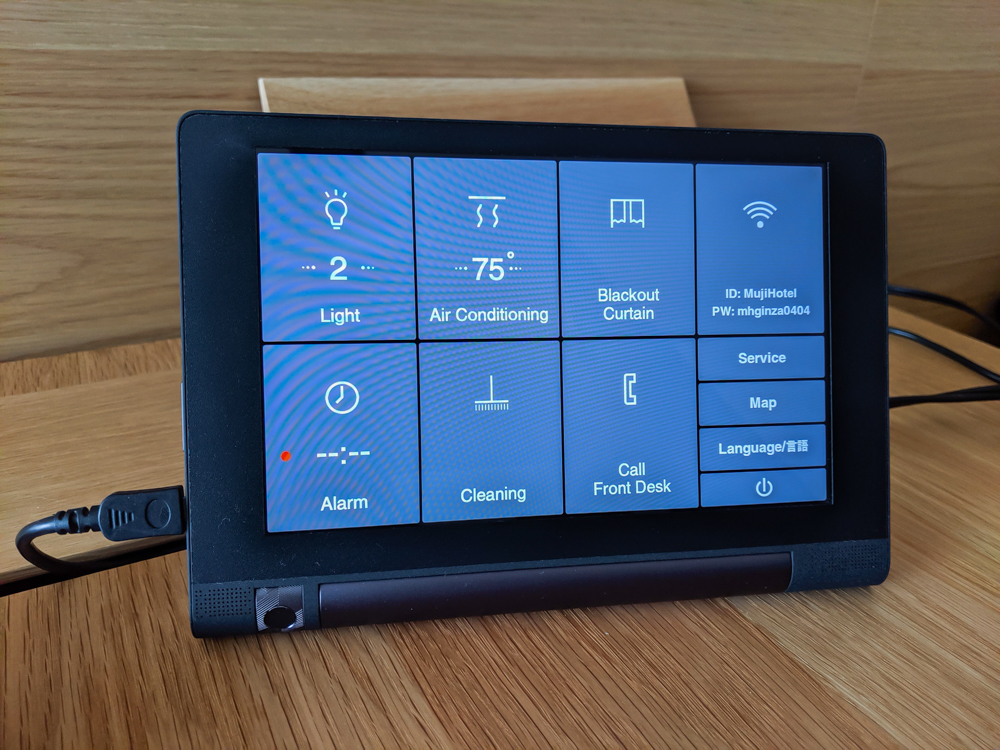
All rooms feature control tablets that allow you to adjust the AC and lights, open and close the blackout curtain, and request service. There were also light controls and outlets at each bedside.
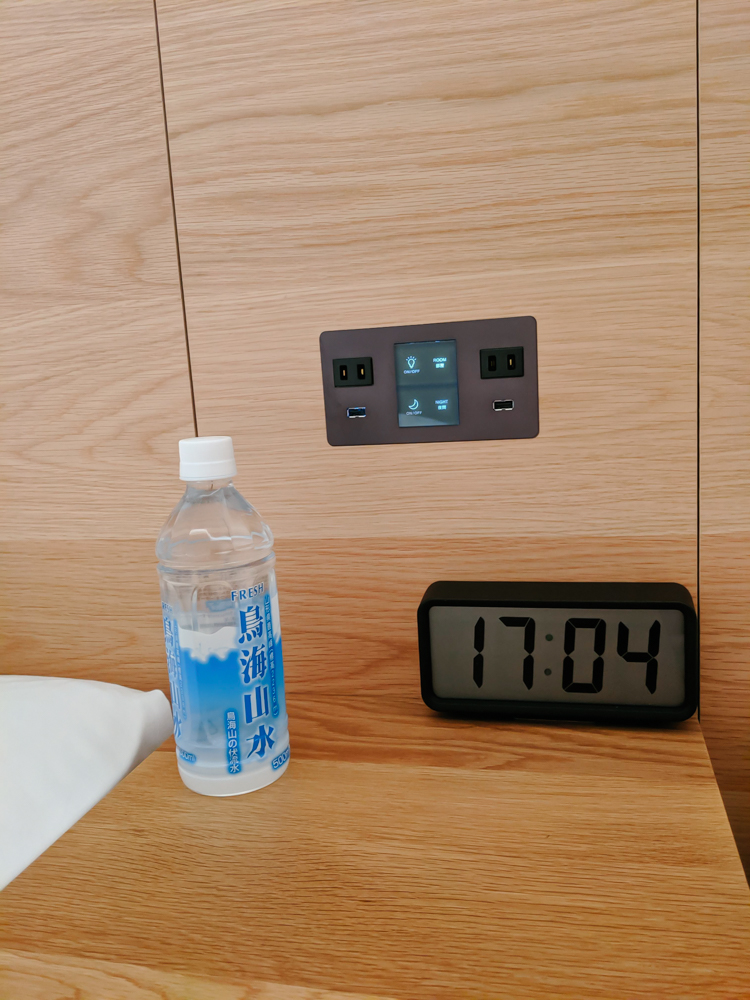
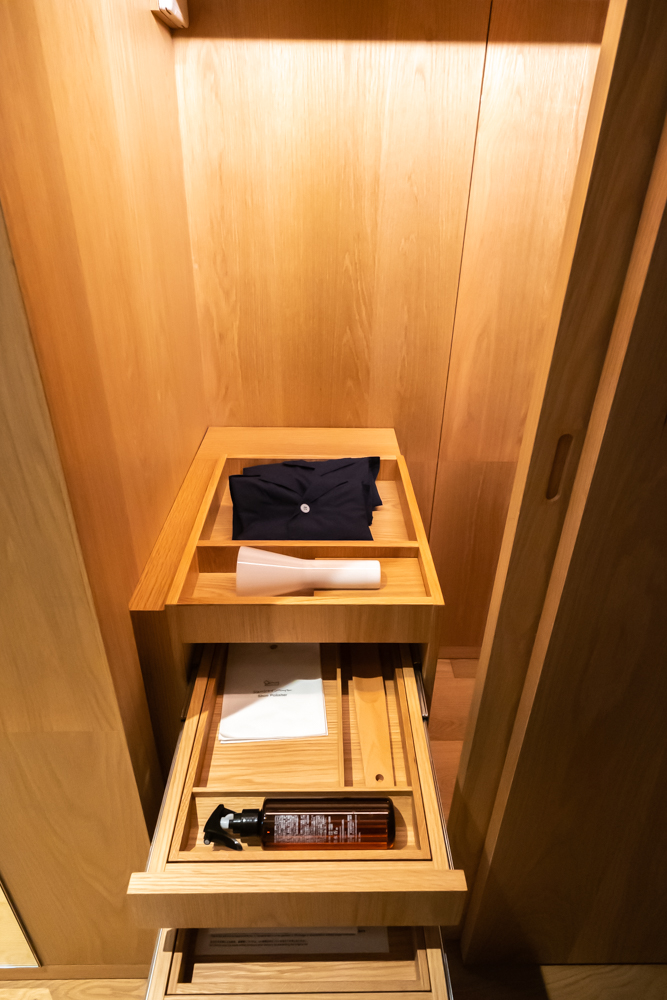
Both rooms also include closets near the entrance with a good amount of room for storage, as well as some basic amenities. The pajamas material felt awful, like a cheap nylon parachute type fabric. I didn’t try them on.
Property
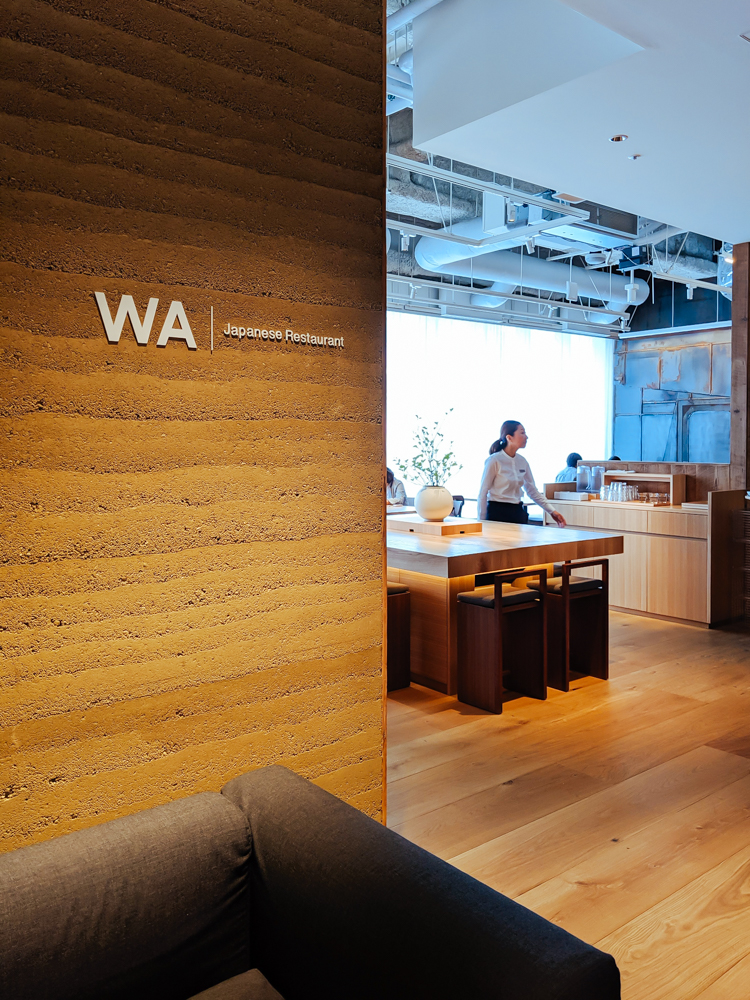
On the 6th floor on either side of the check in desk are Muji’s WA restaurant, and the Salon, a bar serving coffee and cocktails.
I didn’t try WA, or the Muji Diner during our stay. While we’d meant to try the diner, there was already a line when we arrived near opening time, and it just didn’t seem worth a wait. There’s far better food to be had with all of Tokyo in your reach. If you’re in a rush and it’s not busy, give them a try, but it’s a little frustrating competing with the hordes of shoppers and tourists for hotel food.
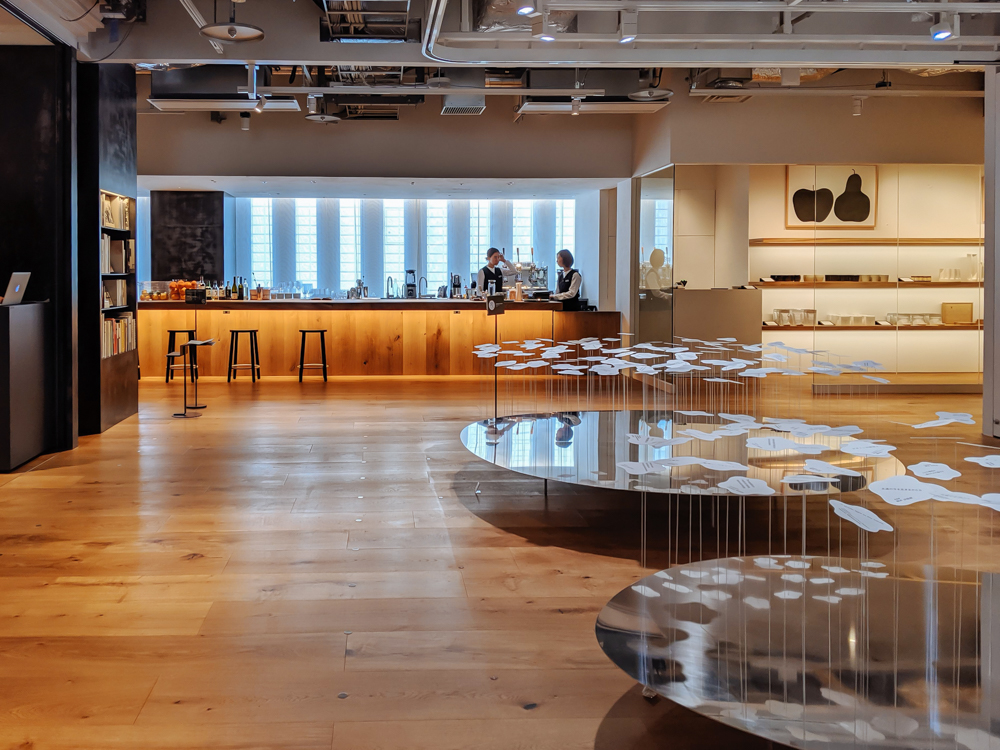
We did however, stop by the Salon one evening once the store had closed. It’s open till 2am and significantly less crowded later in the evening. Drinks, while not mind-blowing for this cocktail snob, were good, with attentive service.
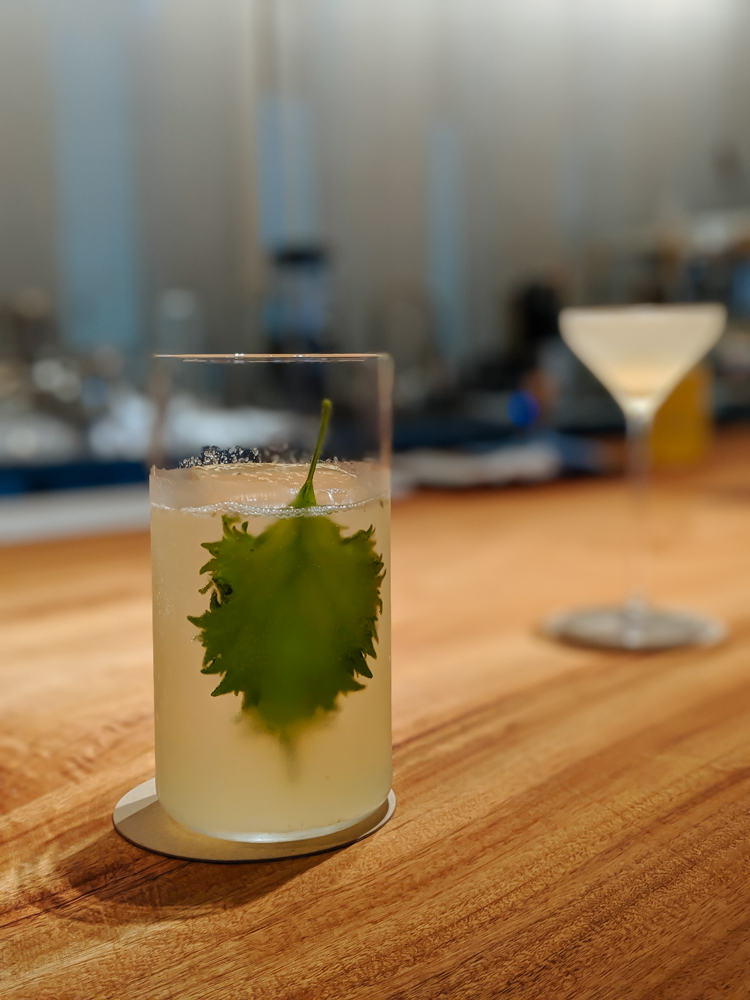

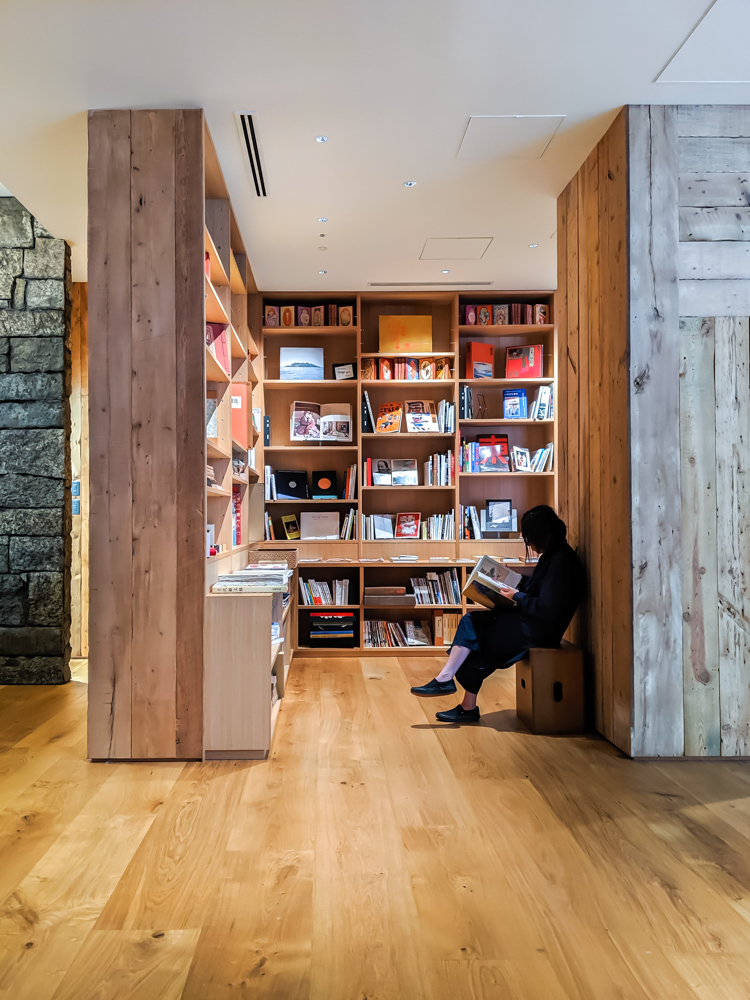
I’m not sure that you can take the books back to your room, but Muji’s library in the lobby features 500 books centered on the theme “Perspectives on Japan” in a variety of languages.
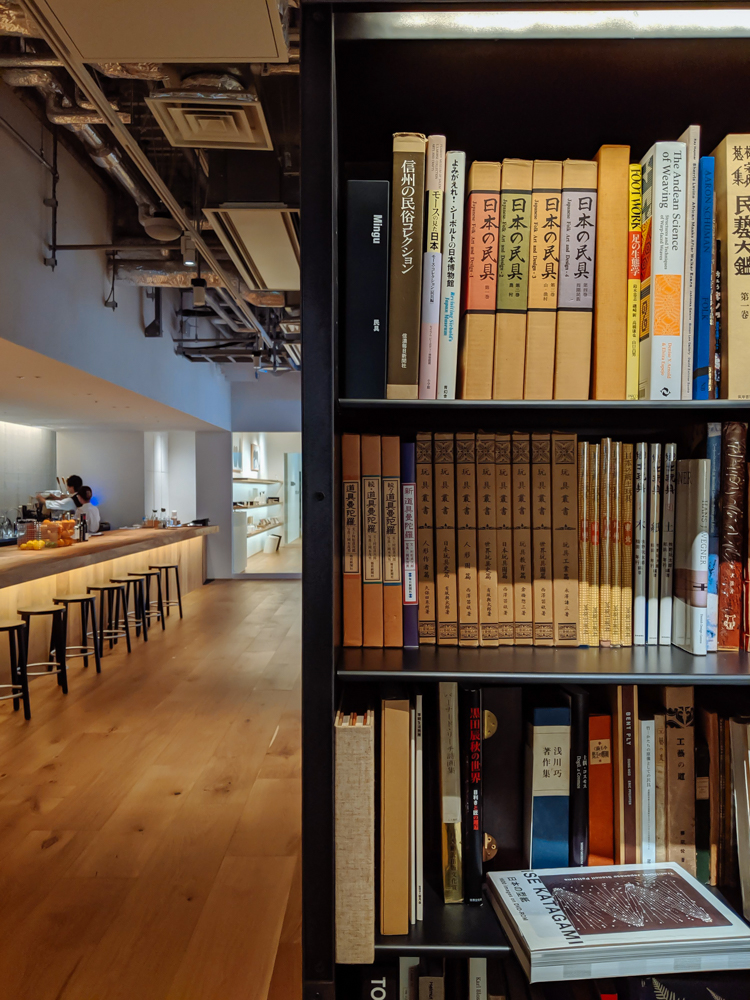
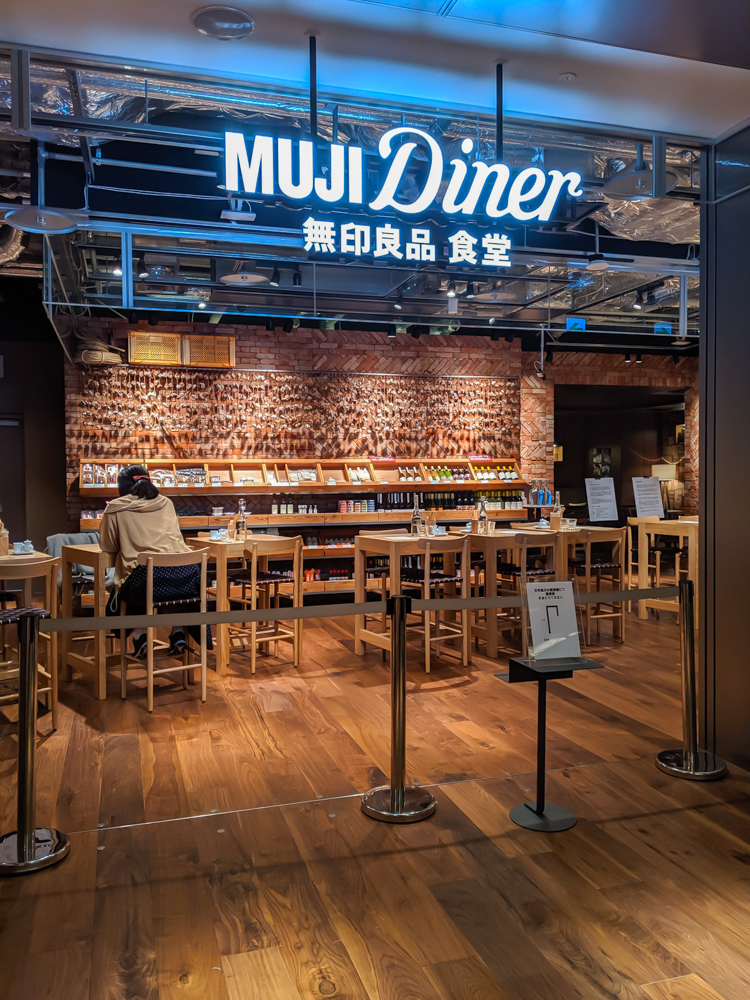
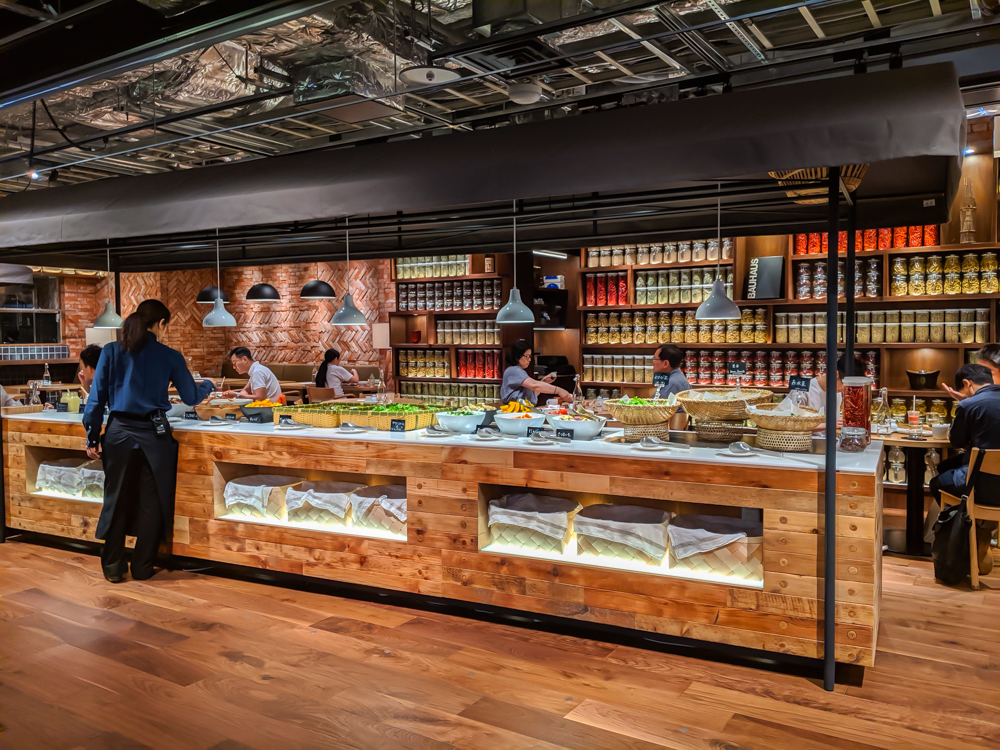
Amenities & Service
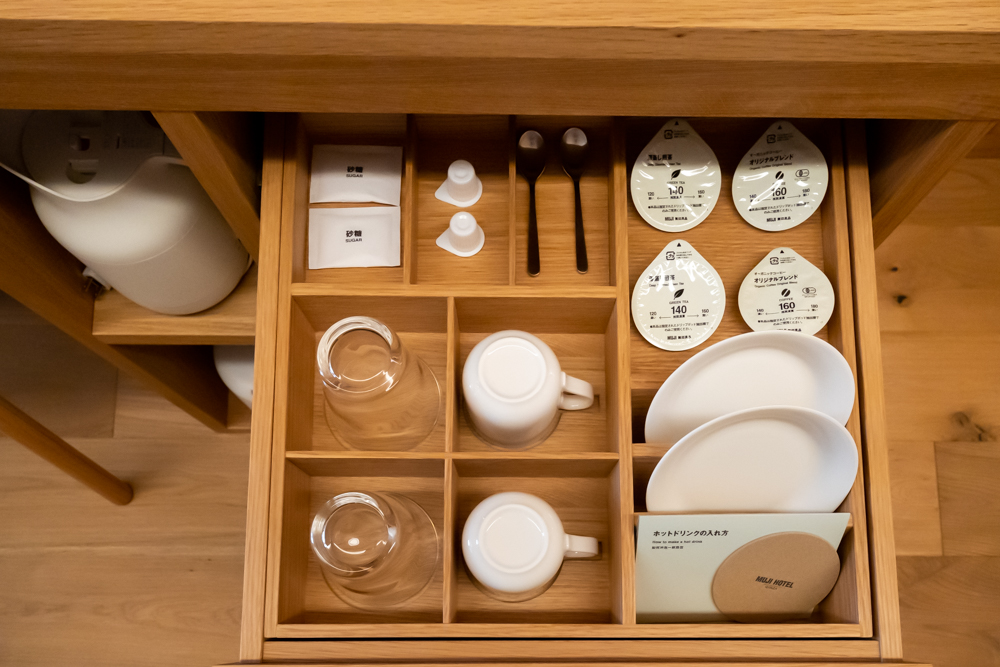
Rooms feature all the Muji products they could muster, though obviously very few items are free to take home with you.
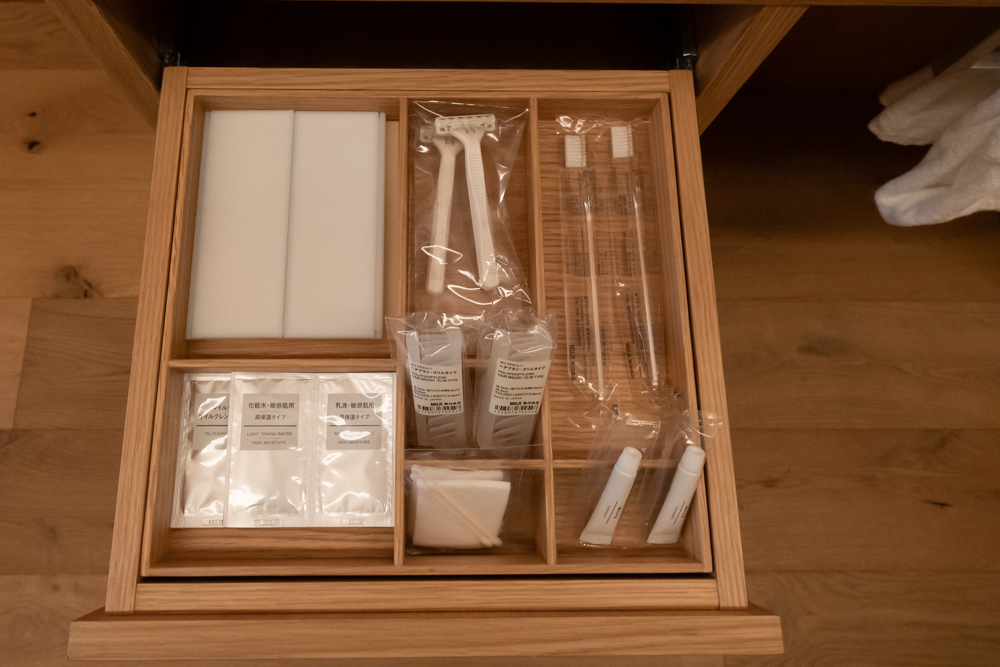
Bathrooms included toothbrushes and toothpaste, combs, razors, lotion and toner, q-tips and cotton pads. The Muji brand shampoo, conditioner and body wash in the shower had a pleasant citrus scent. I’m picky about scents and have very sensitive skin, but these passed the test!

On check-in, you’ll be asked to choose an essential oil scent for the famous Muji aroma diffuser in your room. I went with grapefruit. Not being a fan generally of perfumes, I wasn’t sure if I’d end up with a headache, but I gave it a try. The scent was natural and subtle, and I can see why the diffusers are so hyped.
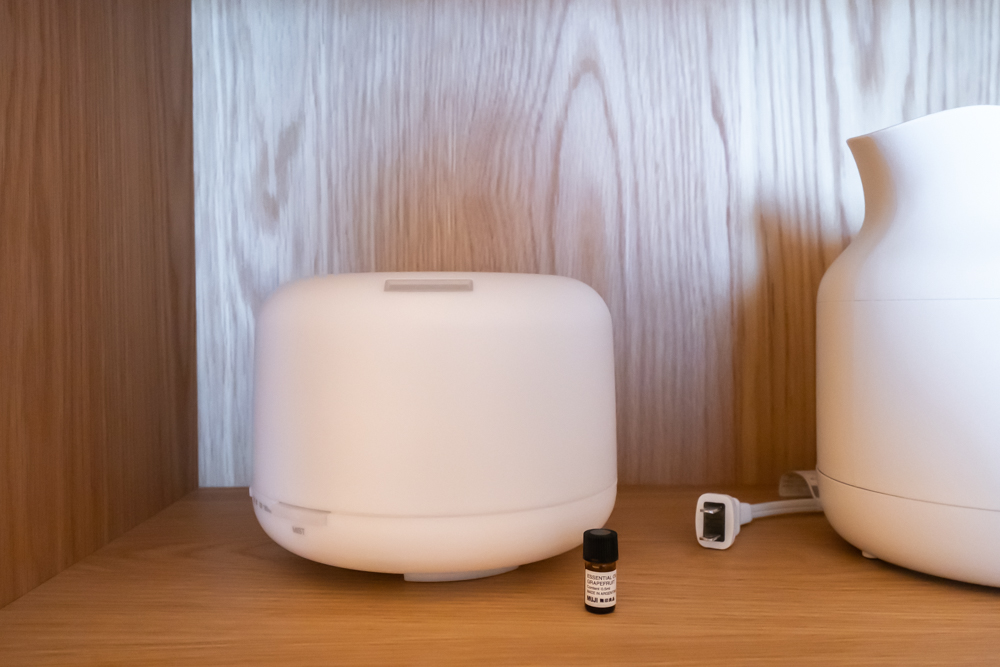
Another cool Muji product in both our rooms was a large air purifier. We use an air purifier at home, both for allergens and for white noise while sleeping. I know some prefer a whisper quiet fan, but I loved that the Muji air purifier could be turned up to a fairly loud fan level.
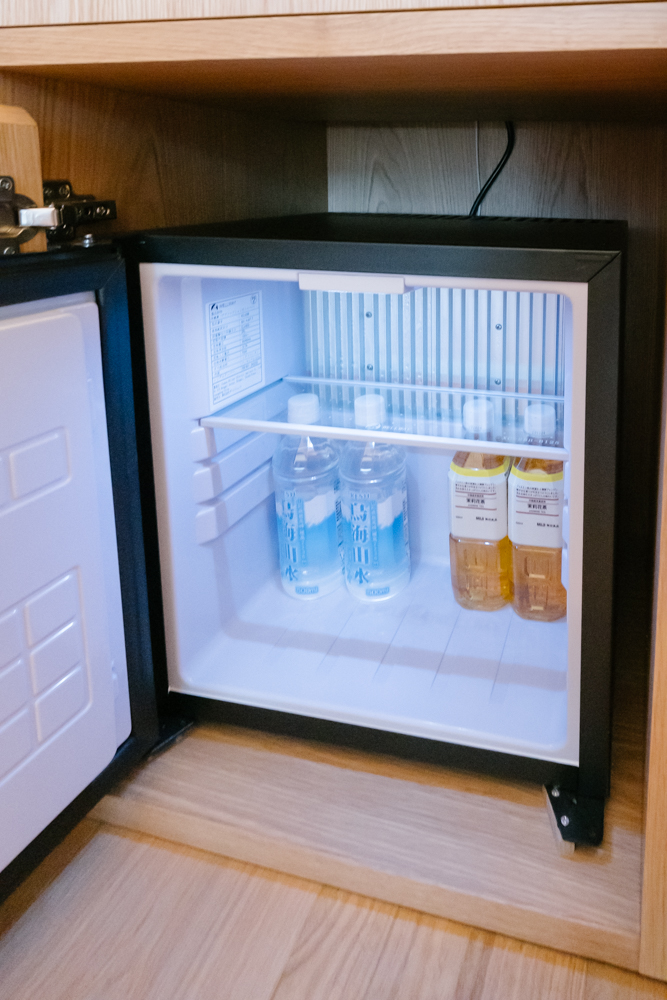
Rooms also have flat screen TVs, a safe, slippers, electric kettle, mini fridges with complimentary water and Muji’s jasmine iced tea, coffee and tea, and small packages of nuts or candies. WiFi is fast and free, and I appreciated the generous 4 total bottles of water and tea.
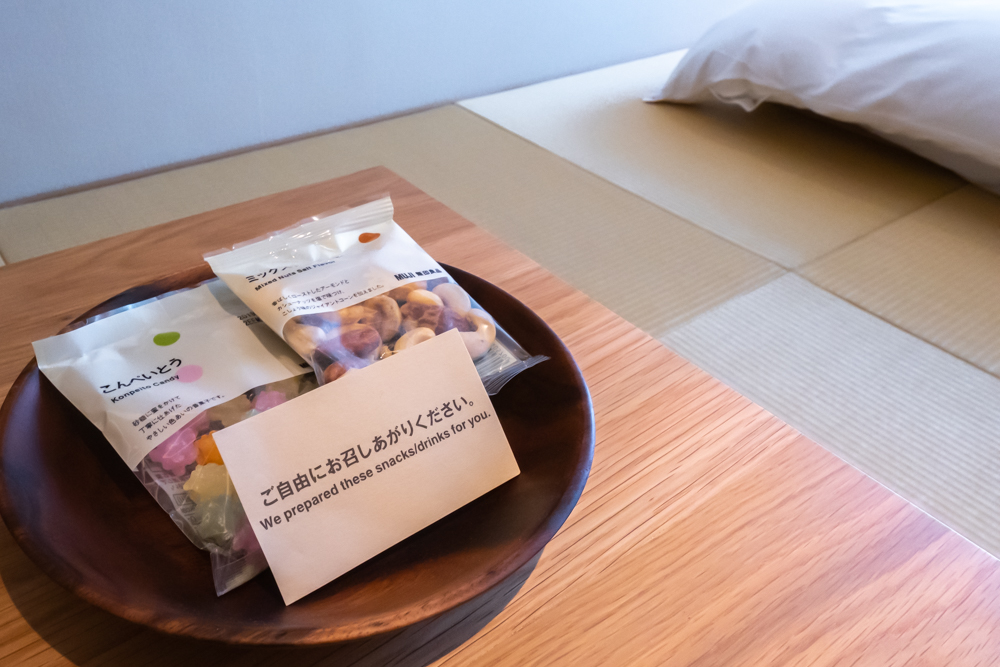
For late night munchies, there were vending machines with Muji drinks and snacks (along with some random items like men’s underwear!) off of the lobby.
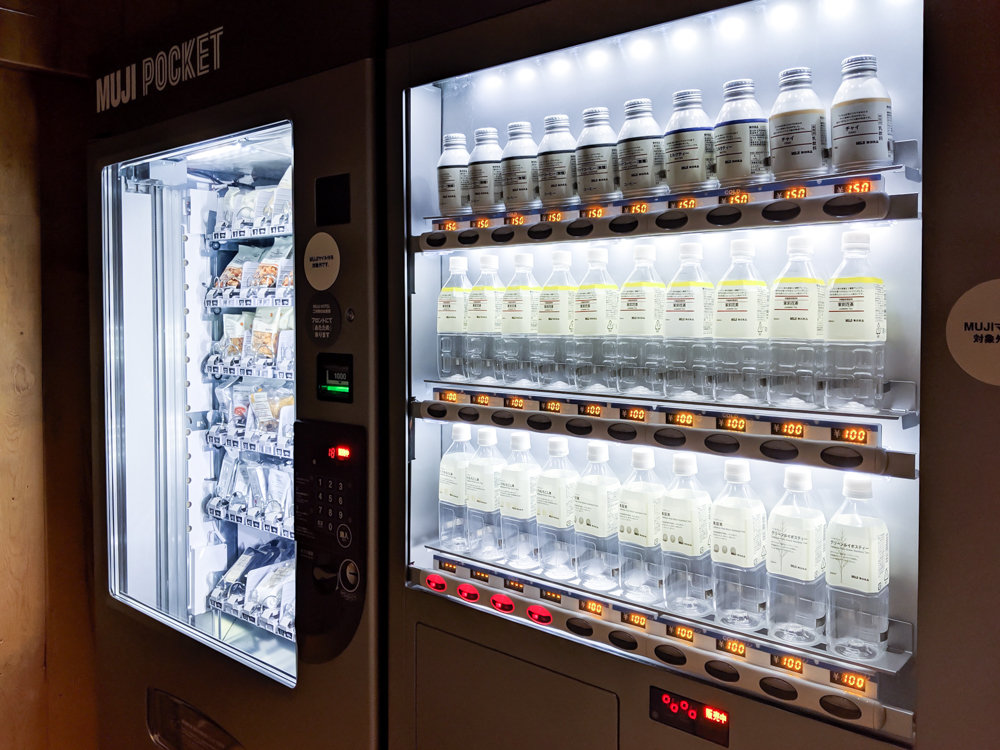
While I did occasionally have a little difficulty communicating, I had no service issues during my stay. The English proficiency of the front desk staff varied, and I apparently threw them for a loop when I asked for some ice for an aching knee (I later figured out I could have gotten it myself next to the vending machines). Staff were polite but seemed confused, so it took about 10 minutes of explaining my request to different staff and waiting in the lobby–but I did get my bag of ice.
When we checked in, they were clearly busy, and again, may not have had the confidence to conduct a longer conversation in English. However, a short orientation to the hotel would have been nice. They did explain the back entrance to the hotel, but didn’t explain where the vending machines and outdoor smoking area (I don’t smoke, but they don’t know that) were hidden, our options for dining, etc.
Because we booked two different room types for our stay, we needed to switch rooms after the first night. They made this very easy to do. While we did need to “check out” by the normal 11am check-out time, we didn’t have to worry about storing our luggage. The front desk staff instructed us to simply leave our bags in our room, and they would be moved to the new room when it was ready. When we returned that day in the late afternoon, we were able to pick up our new key cards at the desk and our luggage was waiting for us in the new room.
Overall Impressions
We enjoyed our stay at Muji Hotel Ginza, and no doubt Muji brand loyalists will find even more to love here.
The Ginza neighborhood isn’t one I’d be in a hurry to return to, however, room rates were reasonable for the area. Rooms were clean, comfortable and attractive, weaving together sleek modernity and traditional Japanese aesthetics. Despite being newly opened, you could see the beginnings of wear in some room materials, so I wonder how rooms will be looking in a year or two.
Again, Muji fans may feel differently, but the appeal of the hotel/ store combo does wear off quickly. The serene rooms and the often overwhelming crowds of the store stand in stark contrast. There aren’t many other hotels where patrons face quite so much competition from other tourists when they’re just trying to grab a quick croissant in the morning. I’d love to see Muji up their service and offer hotel patrons priority at their restaurants, as well as the ability to order room service or order ahead from the bakery and juice bar.
Book Muji Hotel on Muji’s Website, or on Booking.com

